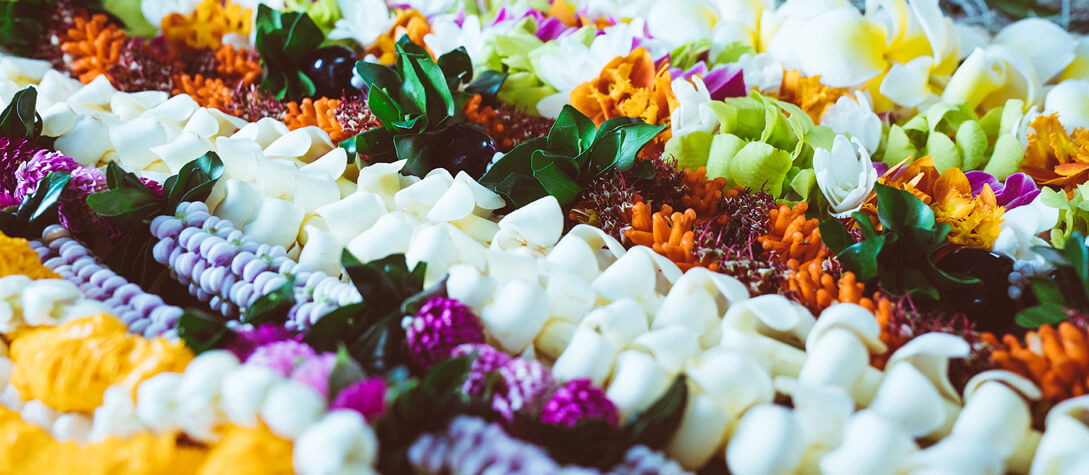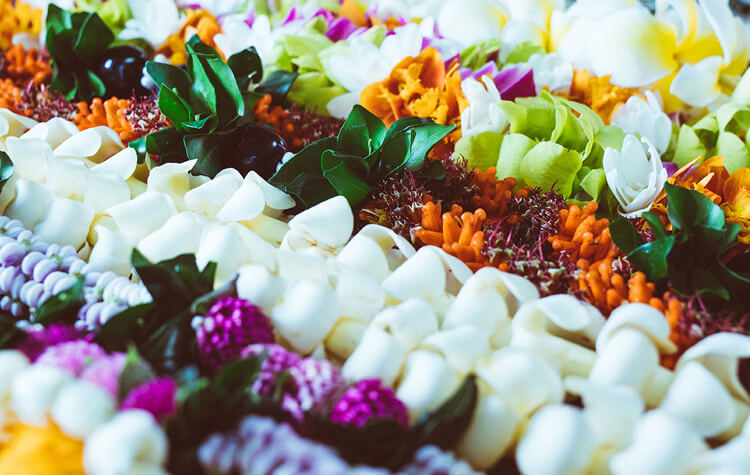An Island Tradition: 'May Day is Lei Day'
Reading time: 6 Minutes
May 1st, 2018
Most of us know the song “May Day is Lei Day in Hawaii,” and that it's customary to give and wear beautiful flower lei on May 1. Some people celebrate by gathering sweet-smelling plumeria from their yard to string a simple lei, or for something fancier, perhaps cream-white puakenikeni. Others buy their lei—maybe delicate pikake, tuberose, or white ginger—strung fresh at a lei stand in Chinatown, or from the day's latest grocery store delivery. It doesn't matter how simple or fancy the lei, or whether you make or purchase it. The result is the same—sharing in a lei-giving and -wearing tradition that contributes to making these Islands the unique and lovely place that they are.
But how did May 1 come to be associated with lei? And did you know that Bank of Hawaii hosted the first Lei Day celebration in its lobby?
May Day became Lei Day in Hawaii in 1928, when artist and poet Don Blanding, an Oklahoma native who lived in Hawaii and wrote for the Honolulu Star-Bulletin, put forward the idea of creating a holiday to celebrate the tradition of making, giving and wearing lei. He mentioned the concept to Star-Bulletin's society editor Grace Tower Warren, who instantly expressed interest. She suggested pairing the holiday with May Day, a day already associated with flowers (which also happened to be her birthday)—and she's the one who coined the now-familiar phrase “May Day is Lei Day in Hawaii.”
Around that time, musicians Leonard “Red" Hawk and Ruth Hawk wrote the now-familiar song about it.
“May Day is Lei Day in Hawaii
Garlands of flowers ev'ry where
All of the colors in the rainbow
Maidens with blossoms in their hair”
That first Lei Day, on May 1, 1928, was promoted by the newspaper and held in the Bank of Hawaii lobby in downtown Honolulu at King and Bishop Streets. Caught up in the spirit, some business people downtown wore lei, though not nearly as many as today. The bank provided prize money for a lei-making competition that had several categories.
Five years before that, in 1923, Hawaii's Territorial Legislature had officially declared a color and lei for each island, and at the first Lei Day competition at Bank of Hawaii, judges took into consideration how well the lei incorporated the islands' flowers and colors.
Princess Abigail Wahiikaahuula Campbell was one of the three judges, along with Elizabeth Lahilahi Webb (lady-in-waiting to Queen Liliuokalani) and Chiefess Lucy Kalanikiekie Davis.
The first-ever Lei Day Queen was 19-year-old Nina Bowman, a University of Hawaii student, who was crowned by Honolulu's mayor of the time, Charles Arnold.
The lei's history, tradition and significance go back far beyond 20th-century Lei Day, of course. The first Hawaiians brought a lei tradition with them from their Polynesian island homes. Then, as now, people made lei from the natural items around them, such as flowers, leaves, shells, feathers, seeds and nuts. People still give lei for the same cultural reasons as were practiced at the time—as a symbol of friendship, celebration, honor, love and greeting.
And there has always been an etiquette to the gifting of lei. Lei placed around the neck is like a symbolic embrace, and it is impolite to refuse a lei or to remove it right away. One should never throw a lei in the trash. It's a lovely idea to share a still-fresh lei with someone else, thereby passing on the mana (spirit) of the person who made it, as well as the mana of the last person who was wearing it. Many people drape a lei over a tree when they are done with it, so the petals can return to the earth.
Around the turn of the 19th century, Reverend Samuel Kapu of Maui wrote the mele Na Lei o Hawaii (the lei of Hawaii) and dedicated it to the goddess Hiiakaikapoliopele. The mele describes Hiiaka's journey across Na Kai Ewalu (the eight seas of Hawaii) and describes which flowers, colors, chiefs, seascapes and landscapes symbolize each island.
Noted kumu Peleuli Amalu set the mele to music, and it was first sung at a church concert on Hawaii Island in 1901. Amalu and her husband continued to perform the mele over the years, and in 1909, the Kaahumanu Society sang it at Honolulu's old Opera House, which stood next to Aliiolani Hale. Young women dressed in the appropriate colors and lei representing the different islands, and acted out the song.
By 1912, the idea that specific colors and flowers represented the different islands had stuck. Yellow and ilima has come to be Oahu's symbols, red and lehua represents Hawaii Island, mokihana and the color violet represents Kauai, the rose and the color pink represents Maui, kaunaoa and the color orange represents Lanai, the color green and the white kukui blossom represents Molokai, pupu shells and the color white represents Niiahu, and last but not least, hinahina and the color grey represents Kahoolawe.
And then in 1928, Lei Day was launched, and developed into an annual event. In the early years, the May 1 festivity was often held at Honolulu's City Hall, where there was a pageant and lei exhibit. Pageant princesses represented each island, wearing lei of the appropriate color and flower, and one was crowned Lei Day Queen each year.
When the event outgrew City Hall, it moved to Kapiolani Park, where it is still held.
Lei Day parades create a lively atmosphere each May 1 throughout the state, complete with beautiful pau riders, and even their horses wear gorgeous lei around their broad necks. At Hawaii's elementary schools, students practice their hula presentations for weeks, make lei and give grand May Day concerts.
Hawaii's most celebrated Lei Day festivities continue each year at Kapiolani Park Bandstand. The lineup includes Hawaiian music, dance, crafts and food, and attendees have the opportunity make their own lei at free workshops. Lei Day Court contestants aspiring to be Lei Day Queen show their skill at making lei, speaking Hawaiian and dancing hula.
And there are lei-making contests for adults and children, as well as ribbon lei-making. The occasion has helped the age-old craft of lei-making continue to thrive across the Islands, and offers an opportunity for attendees to admire some of the most elaborate and exquisite lei Hawaii has to offer.
Another longstanding and moving tradition is what happens to the lei after Lei Day. Every May 2, the gorgeous garlands are exhibited one last time at Kawaiahao Church and at Mauna Ala, the Royal Mausoleum, where many of Hawaii's alii are buried. After closing ceremonies, the public is welcome to handle the elegant lei and help drape them on the crypts.
It's a touching way to honor Hawaii's history—its royalty and the tradition of the lei—and to say aloha to another splendid celebration, until May returns the next year, with its robust array of flowers, fanfare and memorable festivity.
The mention of any individuals or businesses is not an indication of affiliation or endorsement by Bank of Hawaii. The individuals and owners of any other trademarks, logos, brands or other designations of origin shown, named or mentioned herein did not sponsor, endorse or preview this article
You're about to exit BOH.com
Links to other sites are provided as a service to you by Bank of Hawaii. These other sites are neither owned nor maintained by Bank of Hawaii. Bank of Hawaii shall not be responsible for the content and/or accuracy of any information contained in these other sites or for the personal or credit card information you provide to these sites.





